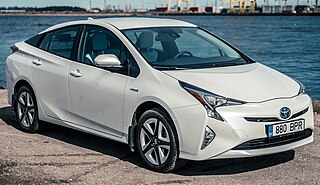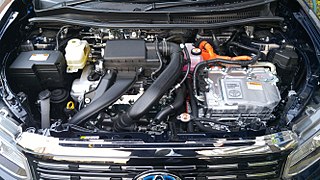
The Toyota Prius is a compact/small family liftback produced by Toyota. The Prius has a hybrid drivetrain, combined with an internal combustion engine and an electric motor. Initially offered as a four-door sedan, it has been produced only as a five-door liftback since 2003.
Hybrid Synergy Drive (HSD), also known as Toyota Hybrid System II, is the brand name of Toyota Motor Corporation for the hybrid car drive train technology used in vehicles with the Toyota and Lexus marques. First introduced on the Prius, the technology is an option on several other Toyota and Lexus vehicles and has been adapted for the electric drive system of the hydrogen-powered Mirai, and for a plug-in hybrid version of the Prius. Previously, Toyota also licensed its HSD technology to Nissan for use in its Nissan Altima Hybrid. Its parts supplier Aisin Seiki Co. offers similar hybrid transmissions to other car companies.

The Toyota NZ engine family is a straight-4 piston engine series. The 1NZ series uses aluminum engine blocks and DOHC cylinder heads. It also uses sequential fuel injection, and has 4 valves per cylinder with VVT-i.

The Toyota AZ engine family is a straight-4 piston engine series. The AZ series uses an aluminium engine block with cast iron cylinder liners and aluminium DOHC cylinder head. The engine series features many advanced technologies including slant-squish combustion chambers, offset cylinder and crank centers, and the VVT-i continuously variable intake valve timing system. The aluminium engine measures 626 mm (24.6 in) long, 608 mm (23.9 in) wide, and 681 mm (26.8 in) tall.

The Toyota Carina is an automobile which was manufactured by Toyota from December 1970 to December 2001. It was introduced as a sedan counterpart of the Celica, with which it originally shared a platform. Later, it was realigned to the Corona platform, but retained its performance image, with distinctive bodywork and interior — aimed at the youth market and remaining exclusive to Japanese Toyota dealerships Toyota Store. It was replaced in Japan by the Toyota Allion in 2001 and succeeded in Europe by the Toyota Avensis.

The Toyota Caldina is an automobile manufactured by Toyota for the Japanese market from 1992 to 2007. It replaced the Corona and Carina wagons, and was sold at Toyota Store and Toyopet Store locations in Japan. While the Caldina has never been officially exported by Toyota, its All-Trac 4WD capability and large capacity have made it a popular grey import in Australia, New Zealand, Russia and many South American countries. When it was discontinued in 2007, the T270 series Avensis wagon/estate assumed its market position.
Toyota Motor Corporation's U family is a family of automatic front-wheel drive/rear-wheel drive/four-wheel drive transmissions found in later vehicle models.
By the end of 2006 there were about 15 hybrid vehicles from various car makers available in the U.S. By May 2007 Toyota sold its first million hybrids and had sold a total of two million hybrids at the end of August 2009.
The Toyota MC platform is a front-wheel drive automobile platform that has underpinned various Toyota and Lexus models from the compact and mid-size categories. MC sits above the older NBC and newer B platforms, but below the Toyota K platform designed for larger models such as the Camry. Automobiles based on the MC chassis started production in 1997 with the Toyota Prius (XW10).
Hybrid vehicle drivetrains transmit power to the driving wheels for hybrid vehicles. A hybrid vehicle has multiple forms of motive power.

A hybrid electric vehicle (HEV) is a type of hybrid vehicle that combines a conventional internal combustion engine (ICE) system with an electric propulsion system. The presence of the electric powertrain is intended to achieve either better fuel economy than a conventional vehicle or better performance. There is a variety of HEV types and the degree to which each function as an electric vehicle (EV) also varies. The most common form of HEV is the hybrid electric car, although hybrid electric trucks, buses, boats and aircraft also exist.

Calty Design Research Incorporated is a Toyota design studio established in 1973. They have two facilities: one in Newport Beach, California for concept designs, and another in Ann Arbor, Michigan for production designs. Calty provides both interior and exterior styling proposals for future Toyota vehicles and advanced design, production color and wheel design concepts for Toyota's product development operations.

The Lexus HS is a dedicated hybrid vehicle introduced by Lexus as a new compact executive car sedan in 2009. Built on the Toyota New MC platform, it is classified as a compact under Japanese regulations concerning vehicle exterior dimensions and engine displacement. Unveiled at the North American International Auto Show in January 2009, the HS 250h went on sale in July 2009 in Japan, followed by the United States in August 2009 as a 2010 model. The HS 250h represented the first dedicated hybrid vehicle in the Lexus lineup, as well as the first offered with an inline-four gasoline engine. Bioplastic materials are used for the vehicle interior. With a total length of 4,700 mm (190 in), the Lexus HS is slightly larger than the Lexus IS, but still smaller than the mid-size Lexus ES.
Toyota concept vehicles are transportation devices manufactured or designed by automobile company Toyota from 2000 to 2009. As their name suggests, these vehicles were concepts, and, as such, many were never released to dealerships. Many were developed in conjunction with other corporations such as Sony or Subaru.
This is a list of concept vehicles from Toyota for the years 2010–2019.
Toyota Motor Corporation's E family is a family of 5/6-speed manual transmissions for FWD/RWD/4WD vehicles.

The Toyota Prius is a full series-parallel hybrid electric compact car developed and manufactured by the Toyota Motor Corporation. The second generation Prius had been completely redesigned as a compact Kammback. The XW20 series represented the second generation of the Toyota Prius, replacing its XW10 predecessor. The United States Environmental Protection Agency (EPA) and California Air Resources Board (CARB) rated the Prius as among the cleanest vehicles sold in the United States based on smog forming and toxic emissions in 2008. Toyota sold about 1,192,000 units of the second generation Prius worldwide.

Toyota vehicles in Japan are distributed to numerous dealership chains throughout the country. Up to May 2020, each dealership chain had a different product offering, with some models restricted to one chain to maintain exclusivity. Since May 2020, every Toyota model in Japan was available in all dealership chains. Current dealership chains include Toyota Store, Toyopet Store, Toyota Corolla Store and Netz Store.










